

|
Home Updates Hydros Cars Engines Contacts Links Contact On The Wire |
Pit Box Extra
Lorenzo Penna
A name that appeared regularly in articles and results form Italian meetings in the early 1950s was that of Lorenzo Penna from Turin. As well as a competitor who built his own cars he built engines commercially that a number of other competitors were using. He is better known for his Dooling inspired Penna 10 seen below, both with logo and without built around 1951/52.
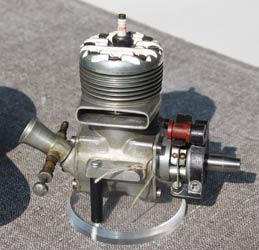 |
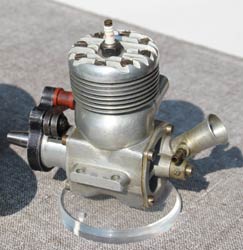 |
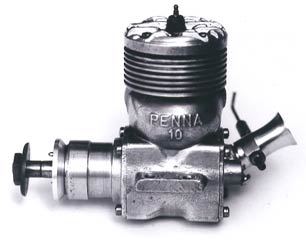 |
|
Dooling inspired Penna 10 in glow form and with what appears to be a McCoy contact breaker assembly |
||
Another of his 10cc motors, the earlier Il Pantera from 1950, also features on a regular basis, although this glow motor owed much less to any existing engine and had a straight venturi. The Pantera had six head screws whilst the 10 had eight screws as can be seen below. The Penna 10 was available in two versions, the P10 Tipo Normale with plain big end and rotary valve bushes at Lit 16,500 and the P10 Tipo Speciale with roller bearing big end and ball bearings to the rotary valve at Lit 18,500.
 |
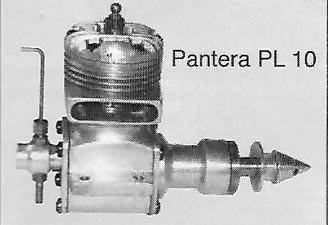 |
| The Pantera | |
Presumably Penna started building engines to use in tethered cars as he was building his own, almost scale cars, to compete with. These featured clutches and gearboxes and were described in some detail in Modellismo. A later venture that still survives is
shown below and is a real engineering tour de force as the entire rear exhaust motor, transmission and gear case is one integrated unit. This unit is then attached to a conventional front half. A fascinating piece of lateral thinking?
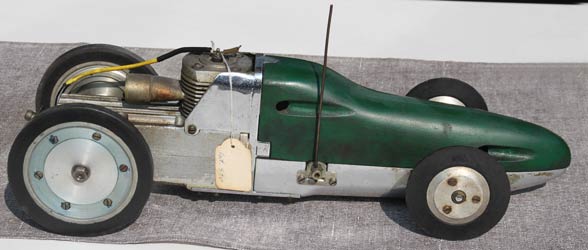
Lorenzo Penna vanishes from results after just a few
years, although his motors carried on for a while, but judging by the engine
below, turned his attention to aircraft motors with this 2.5cc example that
keeps the Dooling style bypass and ported piston. It bears more than a
passing resemblance to his Il Pantera, although 1/4 the capacity.
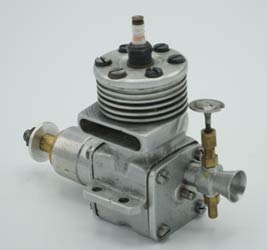 |
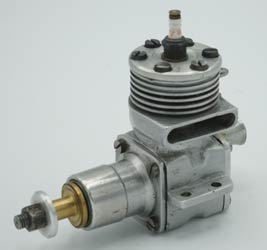 |
 |
Our thanks to the owner for allowing us to use these photographs and supplying us with information. Google translate and Modellismo for results and articles by Penna.
Alberto Dall'Oglio
Alberto is better known by his AD initials, embossed on his highly successful and much sought after racing engines, primarily in .06 and .15 sizes. As with so many other successful engine builders, he was neither an engineer or businessman, just an enthusiast building engines for his own use that turned out to be better than a lot of the commercial engines available. Inevitably, as so often happens, engine building did grow into a business where AD engines became extremely sought after because of their superior performance. However twenty or so years ago he ceased manufacture of these, turning his attention to making superb replicas of early Italian motors such as the Antares and SuperTigre G20.
What is less well known is that in 2002 he also produced a beautiful .09 (1.5cc) sized motor, but only for tethered cars. These were loaned to prominent Italian drivers over the years to test but could not quite meet the performance of the Russian motors. Supply of these was becoming increasingly difficult after the deaths of Weiner, Afanasiev and Kapusikov, so there was a ready market for a replacement motor if they proved satisfactory?
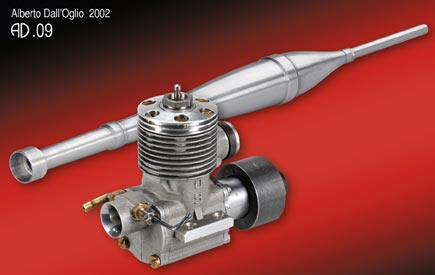 |
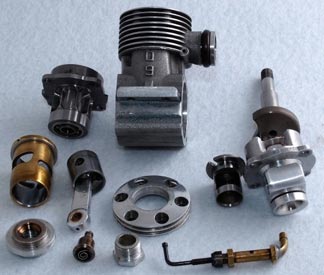 |
| AD 09 motor with Zimmerman disc rear end | AD 09 with a centrifugal drum induction |
Gianni Mattea used an AD motor regularly in the unusual Weiner chassis and around 2018 Alberto started running a car of his own manufacture with an AD motor as well as a Kapusikov car, with an AD. This obviously coincided with the onset of covid followed shortly by Alberto becoming ill, bringing this project to an end as Gianni Mattea has not been seen at a track since then either.

Gianni Mattea's Weiner car with AD motor
|
|
|
| The eagle eyed amongst you will notice the lack of a coupling between the motor and gearbox in each of these photos. | |
Sadly, Alberto died in December 2023 and so far we have yet to locate an example of the car engine. However, noted speed flyer and engine builder, Dave Smith has sent us photos and a short description of an aero version that he built from original parts.
DS: Approximately 3 years ago I asked my friend the late Alberto Dall'Oglio if he manufactured a front induction low exhaust timed version of his AD 09 tether car engine. He confirmed that he only made the car version. Subsequently he sent me a couple of machined crankcases/brass, low timed liner/piston blanks, bearings etc.
I drew up some drawings
in AutoCAD and proceeded to make my version of a front induction engine.
On the test bed results are encouraging and I know that Alberto was
interested in my efforts.
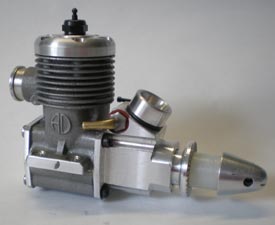 |
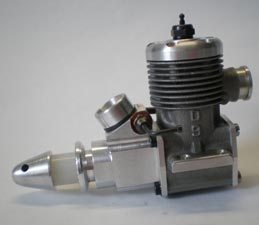 |
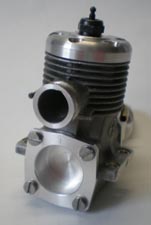 |
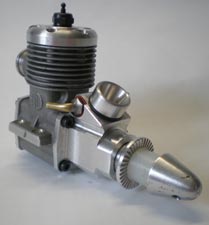 |
A second crankcase went to engine guru Taff Bolen who created this 1.5cc diesel. A third motor converted to aero configuration is in existence with a drum valve, but as yet, no sighting of an original, tethered car motor.
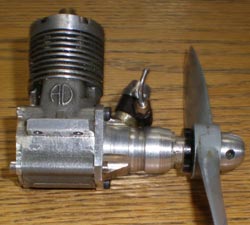 |
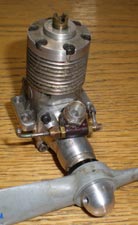 |
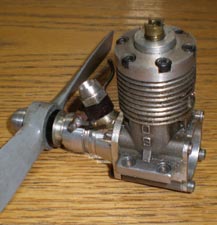 |
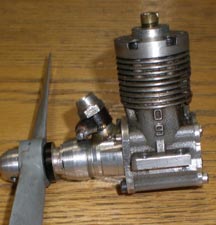 |
Update July 2024: Twenty two years on, the circle is completed.
There are relatively few occasions when I am lost for words, but the world of tethered cars, boats and engines has provided any number of surprises, coincidences and strokes of luck that defy logical explanation. Having published the above material on Alberto Dall'Oglio's AD 09 tethered car motor we had hoped that we might get a glimpse of the one Gianni Mattea had in his car, but unfortunately he has not been travelling post CV. As the photos show, the only other three crankcases known to survive had been converted to aero engine configuration, so that was probably it as far as we were concerned.
|
It was then a wonderful surprise when Gianmauro Castagnetti came up to me in Basel in May with a bag of original AD parts, a machined crankcase, drum valves and Zimmerman back end castings plus some original, composite discs. The surprise became something more humbling when Gianmauro indicated that they were for me, our lack of a common language proving inadequate to the task of me expressing my gratitude and surprise. Below:
Machined crankcase |
|
|
|
As this was the sum total of the parts remaining, I set about asking around for spare 1.5cc items that could be utilised in a reconstruction, and thanks to Philipp Meier I had most of what was needed, apart from the skill and equipment to do it that is. Alan Knight had done a super job on an Oliver for a ZN 2.5cc rebuild so I sent him a photo of the bits and asked if there was any possibility of making what was still missing and rebuilding the motor? Bless him, he took the job on and just a couple of weeks later there was the only other, complete, AD09 tethered car motor known to exist. I was able to pick it up at Buckminster and by coincidence, show to Gianmauro who had travelled over from Italy for the Retrofest. |
Not sure that Gianmauro quite believed that it could have been completed so quickly, but then, neither was I? Still a couple of parts remained to be sourced though, a clamp nut for the glow plug and a needle valve assembly, and oddly, these proved the most difficult, but thanks to Jan Huning are now in place, allowing me to recreate the original AD Advert. I had not realised until looking at the originals that Alberto published two publicity photos of the AD in 2002, one with the tuned pipe attached and one with it beside the motor.
| Broken crank as a
pattern for the new version. Liner fitted, with a more conservative exhaust timing Assembled motor sans NVA and plug clamp screw |
|
|
|
|
The parts in the bag gave some clues as to the development process that Dall'Oglio went through over the lifetime of the motor. As originally built it was fitted with a Zimmerman disc induction, but by and large this is not overly popular in the smaller engines. Multiple winner Rain Teder uses this configuration and told me that in back to back tests the Zimmerman showed no increase in speed, but better acceleration. As well as two Zimmerman back ends there were the castings for two Natalenko style drum valves, again not a usual configuration in cars, but universal in team racing. Oddly, these have rectangular venturis but no indication of where the needle vale was fitted, that is until this photo turned up. The suspicion is that this was a very early, sand cast crankcase. |
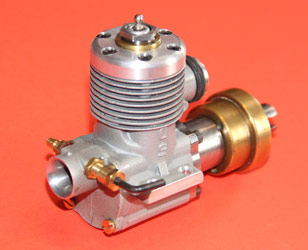 |
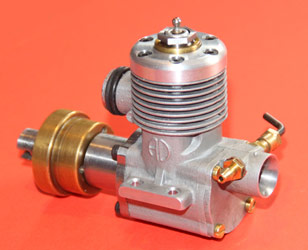 |
| Alberto Dall'Oglio AD 09, recreated 22 years on, thanks to a lot of help | |
|
|
The last version of the motor used a standard Kapusikov style centrifugal drum valve, but to no avail. It was not until an engine was surreptitiously opened and the exhaust measured at a massive 208 degrees that the reasons for the motors apparent failure was realised. The rebuild has reduced this to a more manageable and horseable figure.
|
|
Update Aug 2025: Sadly, negotiations for the chassis fell through, but in a strange quirk of fate, Gianmauro came up trumps again at the 2025 Retrofest with a bag containing all the missing parts for the car version of the motor. Crank, steel and aluminium front housings and a head clamp ring. This leaves something of a quandary, rebuild number two back to original or leave as is?
|
|
Thanks go especially to Dave Smith for being the catalyst for the whole project, along with all the information and photos he has provided. We are also indebted to Salvatore Angeloni and Christoph Zaugg for photos and additional information, but most importantly to Gianmauro Castagnetti for all his help and providing the opportunity to complete the search for an AD 09.
The car and motor was a collaborative effort between two Russian 'sports masters' Mikhail Ossipov and Vladimir Maslonkin, a noted speed flyer.
 |
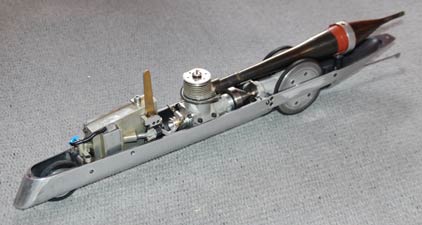 |
|
The Ossipov/Maslonkin car FEMA #17 |
|
|
Mikhail Ossipov came from a family firmly rooted in model cars but through DOSAAF met Sergei Kasanov who was to become his mentor, with Ossipov ultimately becoming head coach at the Moscow car model laboratory. During his career he designed a variety of cars, exploring very different concepts including one of the strangest cars ever, not a sidewinder as such as the engine was vertical but the engine, gearbox tank etc were all in a pan with a straight inner side and a curved outer side with the drive wheels and one front wheel actually outside the car. See right:- The car above, built in collaboration with Maslonkin, was more conventional but again had two alternative bridle connections as he regularly experimented with changing the CofG of his cars. |
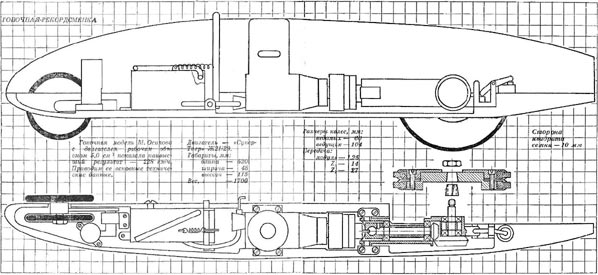 |
Vladimir Maslonkin became a 'Master of Sport' at an early age through speed flying and by 1974 was working at DOSAAF, the design bureau responsible for so much of the development in Russian model sports. His successes were achieved with his own engines but in 1982 he injured himself whilst flying so turned to building tethered cars and engines under the guidance of Ossipov. This collaboration only lasted a couple of years before Maslonkin had an operation and returned to flying speed, as he said that he missed 'the pull of the model' and 'not being in control'.
|
|
|
Ingenious location and operation for suspension dampers |
Almost certainly unique at the time, fully damped suspension with dampers mounted in a compartment under the pan. The front uses a compression damper and the rear a pull damper, now missing. The compartment is sealed with a slide in cover that involved seriously complex and accurate machining. It would be several years before damping became the norm on tethered cars.
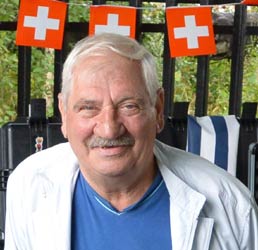 |
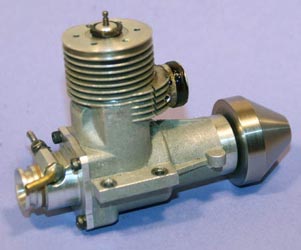 |
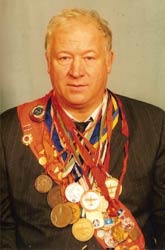 |
| Mikhail Ossipov | Maslonkin 2.5cc motor | Vladimir Maslonkin |
Before returning to flying and retiring from tethered car racing in the late 1980s, Maslonkin made a last trip to Witterswill where he sold his car and two spare engines to multiple European and World 2.5cc champion Peter Arlautzki, who recalled recently that he never made any great speeds with it. Peter sold it on to a SMCC clubmate in 2005 but the car's subsequent history was cut short after just a couple of meetings through a somewhat bizarre accident. At the 2006 European Championships in Pila the car was the first to run after a cable change. For some entirely unknown reason, the cable master did not remove the last of the 1.5cc cars from the track and nor did anyone noticed it as its colour blended in with a banner behind it and that include the person pushing off, perversely not the owner who had been taken to hospital earlier. As the car accelerated and the horser let the cable out, the car hit Jan-Erik Falk's championship winning 1.5 sustaining serious damage. The Ossipov/Maslonkin car was subsequently relegated to the shelf where it has remained ever since.
Thanks to Christoph
Zaugg for photos, details and the sad tale of the car's
demise. As in all articles
that draw material translated from Cyrillic, names are often
spelled in a variety of ways, including the two gentlemen
here. We have used the same spelling throughout.
Update Nov 2025: As mentioned above, the rear damper
was missing from the model, but as they were purpose built
at DOOSAF there was little chance of finding a replacement,
until a chance conversation that is. There lurking in
a drawer for the last twenty years was the missing damper,
plus spares. If that was not enough, from a large crate of
assorted castings came this original pan. The quality of the
casting is amazing, but as everything in the car was unique
to that model, a raw casting it will remain, but reunited
with the car.
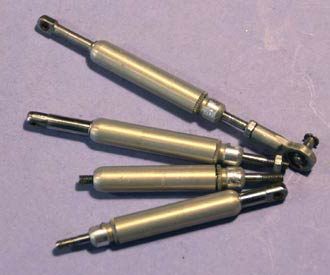 |
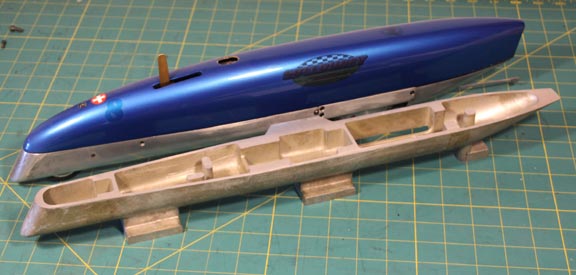 |
| Missing damper plus spares | Maslonkin/Ossipov car along with raw, partly machined casting. |
ęcopyrightOTW2025